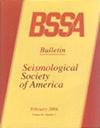Re-Estimating a Source Model for the 1923 Kanto Earthquake by Joint Inversion of Tsunami Waveforms and Coseismic Deformation Data
IF 2.9
3区 地球科学
Q2 GEOCHEMISTRY & GEOPHYSICS
引用次数: 3
Abstract
The 1923 Kanto earthquake generated not only strong motions that caused a devastating disaster around the metropolitan Tokyo area but also a large tsunami. Although the slip distribution of the 1923 Kanto earthquake has been estimated by several researchers, tsunami waveforms observed at tide gauges near the source have never been used. In this study, the slip distribution of the 1923 Kanto earthquake was estimated using joint inversion of tsunami waveforms and vertical crustal deformations reported in historical documents. The estimated slip distribution was generally consistent with those estimated in the previous studies except for a large slip of 9 m along the western portion of the plate interface, up-dip near the Sagami trough. The east coast of the Izu Peninsula was inundated by the tsunami and surveyed after the tsunami to determine tsunami heights in the inundation areas. The tsunami inundation computed from the estimated slip distribution explained the tsunami heights, and the large slip played an important role in large inundation. These results indicate that the large slip west of the Sagami trough is essential for explaining the observed tsunami caused by the 1923 Kanto earthquake.用海啸波形和同震形变资料联合反演重新估计1923年关东地震震源模型
1923年的关东大地震不仅在东京周围造成了毁灭性的灾难,而且还引发了大海啸。虽然有几位研究人员对1923年关东地震的滑动分布进行了估计,但在震源附近的潮汐计观测到的海啸波形从未被使用过。本文利用历史文献报道的海啸波形和地壳垂直形变联合反演,估计了1923年关东地震的滑动分布。估计的滑移分布与以往的研究结果基本一致,除了沿板块界面西侧、相模海槽附近有较大的9 m的上倾滑移。伊豆半岛东海岸被海啸淹没,海啸后进行了调查,以确定淹没地区的海啸高度。根据估计的滑移分布计算出的海啸淹没解释了海啸高度,大滑移在大淹没中起着重要作用。这些结果表明,相模海槽以西的大滑动对解释观测到的1923年关东地震引起的海啸是必要的。
本文章由计算机程序翻译,如有差异,请以英文原文为准。
求助全文
约1分钟内获得全文
求助全文
来源期刊

Bulletin of the Seismological Society of America
地学-地球化学与地球物理
CiteScore
5.80
自引率
13.30%
发文量
140
审稿时长
3 months
期刊介绍:
The Bulletin of the Seismological Society of America, commonly referred to as BSSA, (ISSN 0037-1106) is the premier journal of advanced research in earthquake seismology and related disciplines. It first appeared in 1911 and became a bimonthly in 1963. Each issue is composed of scientific papers on the various aspects of seismology, including investigation of specific earthquakes, theoretical and observational studies of seismic waves, inverse methods for determining the structure of the Earth or the dynamics of the earthquake source, seismometry, earthquake hazard and risk estimation, seismotectonics, and earthquake engineering. Special issues focus on important earthquakes or rapidly changing topics in seismology. BSSA is published by the Seismological Society of America.
 求助内容:
求助内容: 应助结果提醒方式:
应助结果提醒方式:


